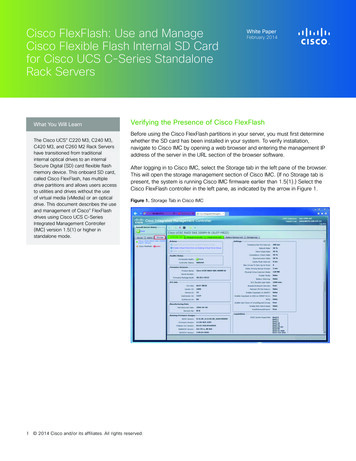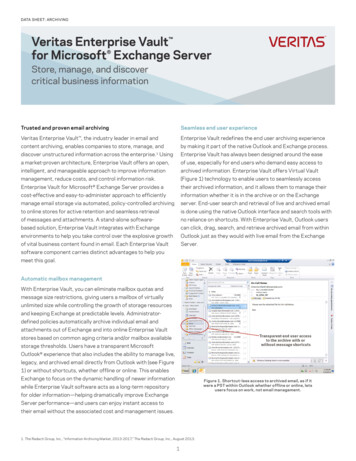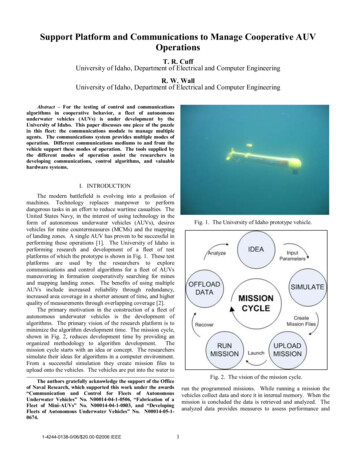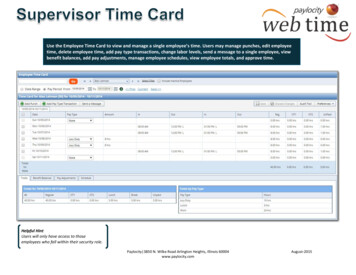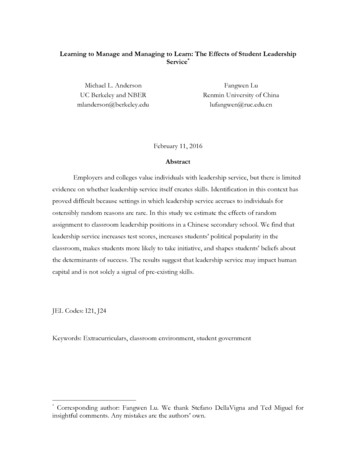
Transcription
Learning to Manage and Managing to Learn: The Effects of Student LeadershipService*Michael L. AndersonUC Berkeley and NBERmlanderson@berkeley.eduFangwen LuRenmin University of Chinalufangwen@ruc.edu.cnFebruary 11, 2016AbstractEmployers and colleges value individuals with leadership service, but there is limitedevidence on whether leadership service itself creates skills. Identification in this context hasproved difficult because settings in which leadership service accrues to individuals forostensibly random reasons are rare. In this study we estimate the effects of randomassignment to classroom leadership positions in a Chinese secondary school. We find thatleadership service increases test scores, increases students’ political popularity in theclassroom, makes students more likely to take initiative, and shapes students’ beliefs aboutthe determinants of success. The results suggest that leadership service may impact humancapital and is not solely a signal of pre-existing skills.JEL Codes: I21, J24Keywords: Extracurriculars, classroom environment, student government*Corresponding author: Fangwen Lu. We thank Stefano DellaVigna and Ted Miguel forinsightful comments. Any mistakes are the authors’ own.
1. IntroductionEmployers and colleges place a high premium on individuals with leadership service,but little is known about what types of skills, if any, leadership service creates. Individualswith leadership or managerial experience in diverse fields – business, politics, and education– are observably different from other individuals. These differences may arise becauseleadership service generates human capital or because these individuals are selected for theirpre-existing skills (or both). It has proven difficult to credibly measure the effects ofleadership service because settings in which leadership service accrues to individuals forostensibly random reasons are extremely rare.In this study we estimate the effects of random assignment to classroom leadershippositions in a Chinese secondary school. In most Chinese schools, teachers select studentsfor classroom leadership positions. These positions carry considerable prestige, and someparents lobby to have their children selected for the positions. In our study, teachersnominated short lists of candidates for each classroom leadership position, and then onecandidate for each position was chosen at random from the nominated list. Exploiting thisrandomization in leadership assignments, we evaluate the effects of leadership service onacademic performance, confidence and aspirations, political popularity, and beliefs about thedeterminants of success.We find that leadership service increases test scores among students most likely toserve in these positions. Some of this increase may be due to incentive effects, and much ofthe experience that the students gain is managerial in nature. Nevertheless, leadership servicealso dramatically increases political popularity in the classroom for these same students.Among students who would typically be runners-up for leadership positions, leadershipservice makes them more likely to take initiative and affects their beliefs about thedeterminants of success. Overall the results suggest that service in classroom leadershippositions can impact human capital and is not solely a signal of pre-existing skills.2. Literature ReviewA large body of literature in economics focuses on whether and how leaders canaffect group outcomes and on what types of traits leaders exhibit. For example, Bertrand andSchoar (2003), Chattopadhyay and Duflo (2004), and Jones and Olken (2005) present1
evidence that leaders appear to affect group performance in corporations, local villages, andcountries respectively. Beaman et al. (2009; 2012) demonstrate that female village leadershipreduces prejudice and increases aspirations among girls. Hermalin (1998) argues that acritical trait for leaders is the ability to send credible signals to followers – they must “lead byexample.” Andreoni (2006) and Güth et al. (2007) explore the effects of leadership andleading by example in public good contributions. Camerer and Lovallo (1999) andMalmendier and Tate (2005) show that leaders tend to be overconfident and can createmarket distortions. In contrast to this rich literature, however, there is little work thatexplores the effects of leadership on the leaders themselves.One exception is research by Kuhn and Weinberger (2005) that documents a highreturn to high school leadership service in the United States. Individuals with high schoolleadership service earn from 4 to 33 percent more than individuals without high schoolleadership service. This return is comparable to the return on an additional 0.5 to 4 years ofeducation (i.e., at the high end it affects wages as much as getting a college education). It isdifficult to distinguish whether firms pay more for individuals with leadership servicebecause the service itself is valuable or whether they pay more because the service signalsthat the worker has special skills that existed prior to the leadership service. Nevertheless,there is suggestive evidence that leadership service may have a causal effect; studentsattending schools with more leadership opportunities earn more than those attendingschools with fewer leadership opportunities.Outside of economics, a substantial literature in psychology studies the effects ofpower upon individuals. For example, individuals primed to feel powerful are more likely totake initiative (Galinksy et al. 2003), more likely to engage in risky behavior (Anderson andGalinsky 2006), and more self-oriented (Galinsky et al. 2006). This literature is related to ourresearch in that a leadership position implies some degree of power, but our interest is in theeffects of the entire leadership experience, not simply the power it entails. In summary, tothe best of our knowledge our research represents the first experimental evidence of theeffects of leadership service on leaders themselves.3. Classroom Setting and Experimental Design2
In most Chinese secondary schools, students sit in the same classroom with the sameclassmates over the entire semester, and teachers of different subjects rotate betweenclassrooms throughout the day. Students in the same classroom not only take classestogether but also conduct various extracurricular activities together, including cleaningclassrooms, attending sporting events, taking part in festivals, and going on field trips.Typically a class has a student leadership structure as shown in Figure 1. There areseven major class leadership positions: class monitor, vice class monitor, labor commissary,entertainment commissary, Chinese delegate, English delegate, and math delegate. The classmonitor is at the top of the management structure, and she assumes a wide range ofresponsibilities – representing the class, organizing collective activities, and maintainingorder in the class. At the beginning of each lecture, the class monitor calls all students to“stand up” to greet teachers. The vice class monitor assists the class monitor, especially inmaintaining order in the class, i.e., keeping students from talking aloud or moving aroundduring class time. The labor commissary assigns students to various cleaning tasks andmonitors the performance of these tasks.1 The entertainment commissary organizes singingand dance performances for school events or festivals and updates the bulletin boardperiodically. Course delegates are assigned for each major subject: Chinese, English, andmath. They urge students to turn in homework, collect and distribute homework for therelevant subjects, and sometimes assist in grading homework. At the beginning of everymorning there is a 30-minute reading-aloud section, and Chinese and English delegatesrotate to lead this section. In addition to these seven major class leader positions, there maybe other minor class leader positions: course delegates for less important subjects, othercommissaries, and leaders of sub-classroom teams. What is common to all the major classleaders is that they have more exposure to teachers and other students and, to varyingdegrees, they must motivate other students in order to fulfill their responsibilities.It is notable that the leadership positions entail a mixture of leadership opportunitiesand managerial responsibilities. While there is no universal definition of what qualifies asleadership, most definitions imply that leadership relates to social influence rather than directapplication of authority. In this context the monitor positions may involve some exercise of1 In most primary and secondary schools, students are responsible for cleaning the floor, windows, and walls oftheir classroom. Public areas, like stairs and playgrounds, are also allocated to each class as responsibility areas.A labor commissary can ask students to redo some cleaning work if she finds it inadequate.3
leadership skills; at a minimum, organizing activities and maintaining order will be mucheasier for students who can exercise social influence, as a student leader’s authority is muchmore limited than, for example, a teacher’s. The commissary and delegate positions, incontrast, are more managerial in nature. The organizational and planning skills necessary forthese positions are important but different from leadership skills. In theory these differencesrepresent an effect to test for effect heterogeneity by position type, but in practice samplesize limits our statistical power.2In general there is excess demand for class leader positions. In a survey amongentering Grade 7 students in a school close to our study’s school, students were asked toreport whether they agreed with the statement, “If there is an opportunity, I want to becomea class leader”. Thirteen percent of students “strongly” or “somewhat” disagreed, 23% ofstudents indicated a neutral opinion, 30% “somewhat” agreed, and 33% “strongly” agreed.Thus, though over 60% of students express interest in holding a class leadership position,less than 15% of them can hold such a position in any given year.Teachers typically appoint class leaders, and there are no explicit rules for selection.3,4Teachers usually have three goals when selecting class leaders: (1) to fulfill theresponsibilities of the positions; (2) to provide role models for other students; and (3) toreward good students with leadership positions. Thus they choose students with acombination of both managerial abilities and academic performance, with more emphasis onmanagerial abilities for commissaries and more emphasis on academic performance forcourse delegates. Given that there is high demand for class leadership positions, parentssometimes lobby teachers to appoint their children to these positions.Teachers appoint class leaders at the beginning of the semester. During the semester,as more information becomes available, teachers may adjust the appointments. For example,teachers may strip a student’s leadership title if the student violates school rules by fightingwith others or if they see a class leader is not performing his responsibilities. In additionWhen estimating effects separately by position, we find suggestive evidence that class monitor positions –particularly the head class monitor position – have larger effects on test scores than other positions. However,these results only achieve marginal statistical significance at best.3 Each classroom has an administrative teacher. The administrative teacher is a regular teacher with additionalmanagerial responsibilities, which include arranging class events, disciplining misbehavior, communicating withparents, and maintaining classroom order. The administrative teacher typically appoints the leaders.4 In some schools and classrooms, class leaders are elected democratically by all students or rotate among allstudents. Most frequently in primary and secondary schools, however, teachers select class leaders.24
teachers may also reappoint class leaders if a leader does very poorly in the midterm exam orif a non-leader does exceptionally well.The endogenous appointment of class leaders under normal circumstances preventsa credible analysis of the effects of leadership service. Our experiment modifies how classleaders are appointed. In this experiment, teachers were asked to nominate two candidatesfor each leadership position using to their normal criteria. They ranked these two candidatesas Candidate 1 and Candidate 2, with Candidate 1 being their first choice for the position.We told teachers before the selection process that one candidate would be randomlyassigned as the class leader and that either candidate had the same chance of being appointed.We randomly assigned one out of each pair of candidates for the position.The randomization procedure was performed without replacement as follows.Among the seven classes in Grade 7, Classes 1, 4, 5, and 7 were assigned to Group 1, andClasses 2, 3, and 6 were assigned to Group 2. For Group 1 classes, we chose Candidate 1 tobe actual leaders for class monitor, entertainment commissary, and Chinese delegate, andCandidate 2 for vice class monitor, labor commissary, English delegate, and math delegate.For Group 2 classes, we did the reverse. The goal of this procedure was to ensure that: (1)Candidate 1 and Candidate 2 students were perfectly balanced across “appointed” and “nonappointed” groups; (2) each class had as close to 50% Candidate 1 students appointedleaders as possible; (3) in each class both Candidate 1 and Candidate 2 students wererepresented in class/vice class monitor positions, commissary positions, and course delegatepositions. While all of these results would occur in expectation with a simple randomassignment procedure, our strategy of sampling without replacement ensures that balance isachieved on all three of these dimensions. This is notable given the small size of our sample.We asked teachers to avoid adjustment
Learning to Manage and Managing to Learn: The Effects of Student Leadership Service* February 11, 2016 Abstract Employers and colleges value individuals with leadership service, but there is limited evidence on whether leadership service itself creates skills. Identification in this context has


